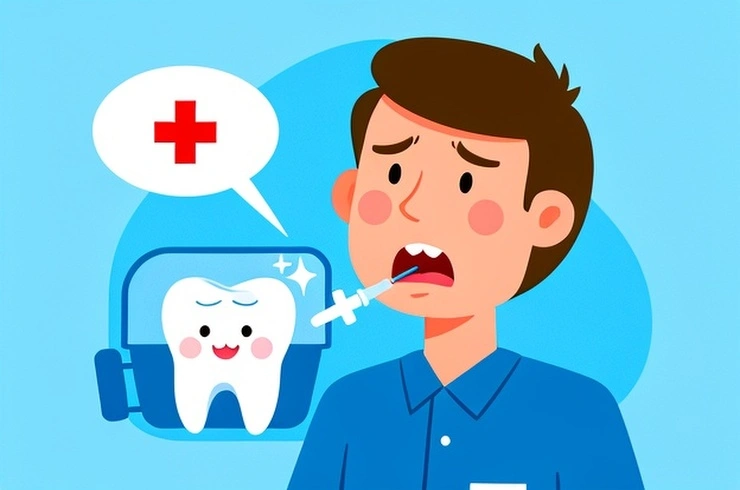
Dental emergencies can be alarming, but knowing how to react immediately can significantly impact the outcome. Ignoring any injury to the teeth or gums can lead to severe consequences, including irreversible damage and the need for complex, expensive procedures later. Here's a breakdown of how to manage common dental crises before you can see a professional:
Toothaches:
Begin by thoroughly rinsing your mouth with warm water. Gently use dental floss to dislodge any food particles that might be stuck. If swelling is present, apply a cold compress to the outside of your cheek or mouth. Crucially, never place aspirin or any other painkiller directly on the gums near the aching tooth, as this can cause tissue burns. Seek dental attention as soon as possible.
Chipped or Broken Teeth:
If you find any pieces of the tooth, collect them. Rinse your mouth and the tooth fragments with warm water. For bleeding, apply a piece of gauze to the affected area for approximately 10 minutes, or until the bleeding stops. To minimize swelling and pain, apply a cold compress to the outside of your mouth, cheek, or lip near the injury. Contact your dentist without delay.
Knocked-Out Tooth:
Time is critical for a knocked-out tooth. Locate the tooth and handle it only by the crown (the visible part). If it's dirty, gently rinse the root with water, but do not scrub it or remove any attached tissue. If possible, try to reinsert the tooth into its socket, ensuring it's facing the correct way, but never force it. If reinsertion isn't possible, keep the tooth moist by holding it in your mouth on the way to the dentist, or place it in a small container of milk or a cell growth medium product like Save-a-Tooth. The highest chance of saving the tooth is if it's re-implanted within one hour. See your dentist immediately.
Extruded (Partially Dislodged) Tooth:
Seek immediate dental care. Until you can reach your dentist, apply a cold compress to the outside of your mouth or cheek to relieve pain. Over-the-counter pain relievers like Tylenol or Advil can also be used if necessary.
Objects Caught Between Teeth:
Attempt to dislodge the object gently and carefully using dental floss. If unsuccessful, do not use sharp objects like pins, as these can cut your gums or scratch your teeth. Instead, see your dentist.
Lost Filling:
As a temporary solution, you can stick a piece of sugarless gum into the cavity (sugar-filled gum will cause pain) or use an over-the-counter dental cement. Schedule an appointment with your dentist as soon as possible.
Lost Crown:
If your crown falls off, collect it and make an immediate appointment with your dentist. If you experience pain and cannot get to the dentist right away, apply a small amount of clove oil (available at drugstores or grocery stores) to the sensitive area using a cotton swab. If possible, re-seat the crown by coating its inner surface with over-the-counter dental cement, toothpaste, or denture adhesive. Do not use super glue.
Broken Braces and Wires:
If a wire is poking your cheek, tongue, or gum, try to gently push it into a more comfortable position using the eraser end of a pencil. If repositioning isn't possible, cover the end with orthodontic wax, a small cotton ball, or a piece of gauze until you can see your orthodontist. Never attempt to cut the wire yourself, as you could swallow or inhale it.
Loose Brackets and Bands:
Temporarily reattach loose braces with a small piece of orthodontic wax, or place the wax over the braces for cushioning. Contact your orthodontist as soon as possible. If a band is loose, save it and call your orthodontist for an appointment to have it re-cemented or replaced.
Abscess:
Abscesses are serious infections around a tooth root or between teeth and gums. They can cause significant tissue damage and spread to other parts of the body if untreated. If you notice a painful, pimple-like swelling on your gum, see your dentist immediately. In the interim, rinsing your mouth several times a day with a mild salt water solution (1/2 teaspoon of table salt in 8 ounces of water) can help ease pain and draw out pus.
Soft-Tissue Injuries:
Injuries to the tongue, cheeks, gums, and lips can cause bleeding. To control bleeding:
Rinse your mouth with a mild salt-water solution.
Apply pressure to the bleeding site with a moistened piece of gauze or a tea bag for 15 to 20 minutes.
Hold a cold compress to the outside of the mouth or cheek for 5 to 10 minutes to help control bleeding and relieve pain.
If bleeding persists, seek immediate dental care or go to a hospital emergency room, continuing to apply pressure with gauze until you receive treatment.
Preventing Sports-Related Tooth and Mouth Injuries:
Prevention is key. When participating in sports:
Mouthguards: Always wear a mouthguard to protect your teeth and mouth.
Face Cages: Consider face cages for sports positions that pose a higher risk of facial trauma, such as baseball catcher or hockey goalie.
Helmets: While most helmets don't protect teeth, wearing a sport-specific helmet is crucial for protecting your head and preventing concussions.
Pro Tip
The content of the article is shared by netizens, please carefully identify it